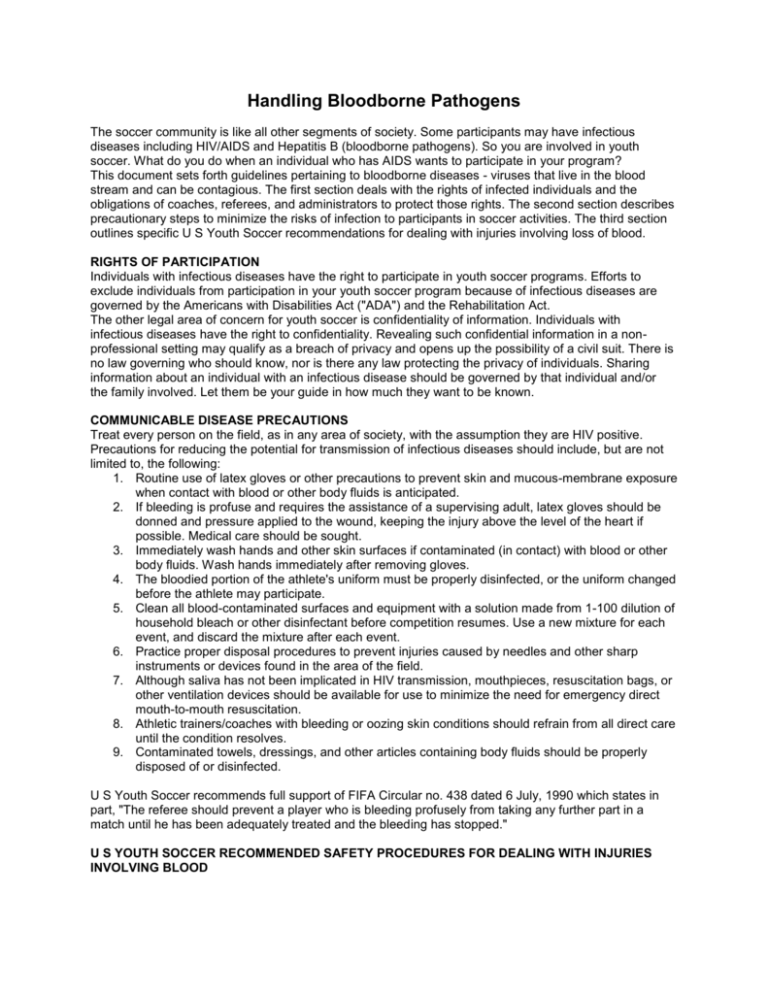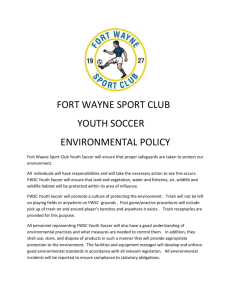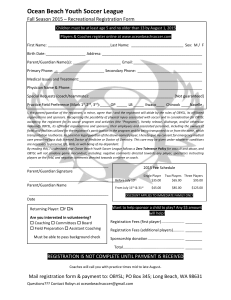Handling Bloodborne Pathogens
advertisement

Handling Bloodborne Pathogens The soccer community is like all other segments of society. Some participants may have infectious diseases including HIV/AIDS and Hepatitis B (bloodborne pathogens). So you are involved in youth soccer. What do you do when an individual who has AIDS wants to participate in your program? This document sets forth guidelines pertaining to bloodborne diseases - viruses that live in the blood stream and can be contagious. The first section deals with the rights of infected individuals and the obligations of coaches, referees, and administrators to protect those rights. The second section describes precautionary steps to minimize the risks of infection to participants in soccer activities. The third section outlines specific U S Youth Soccer recommendations for dealing with injuries involving loss of blood. RIGHTS OF PARTICIPATION Individuals with infectious diseases have the right to participate in youth soccer programs. Efforts to exclude individuals from participation in your youth soccer program because of infectious diseases are governed by the Americans with Disabilities Act ("ADA") and the Rehabilitation Act. The other legal area of concern for youth soccer is confidentiality of information. Individuals with infectious diseases have the right to confidentiality. Revealing such confidential information in a nonprofessional setting may qualify as a breach of privacy and opens up the possibility of a civil suit. There is no law governing who should know, nor is there any law protecting the privacy of individuals. Sharing information about an individual with an infectious disease should be governed by that individual and/or the family involved. Let them be your guide in how much they want to be known. COMMUNICABLE DISEASE PRECAUTIONS Treat every person on the field, as in any area of society, with the assumption they are HIV positive. Precautions for reducing the potential for transmission of infectious diseases should include, but are not limited to, the following: 1. Routine use of latex gloves or other precautions to prevent skin and mucous-membrane exposure when contact with blood or other body fluids is anticipated. 2. If bleeding is profuse and requires the assistance of a supervising adult, latex gloves should be donned and pressure applied to the wound, keeping the injury above the level of the heart if possible. Medical care should be sought. 3. Immediately wash hands and other skin surfaces if contaminated (in contact) with blood or other body fluids. Wash hands immediately after removing gloves. 4. The bloodied portion of the athlete's uniform must be properly disinfected, or the uniform changed before the athlete may participate. 5. Clean all blood-contaminated surfaces and equipment with a solution made from 1-100 dilution of household bleach or other disinfectant before competition resumes. Use a new mixture for each event, and discard the mixture after each event. 6. Practice proper disposal procedures to prevent injuries caused by needles and other sharp instruments or devices found in the area of the field. 7. Although saliva has not been implicated in HIV transmission, mouthpieces, resuscitation bags, or other ventilation devices should be available for use to minimize the need for emergency direct mouth-to-mouth resuscitation. 8. Athletic trainers/coaches with bleeding or oozing skin conditions should refrain from all direct care until the condition resolves. 9. Contaminated towels, dressings, and other articles containing body fluids should be properly disposed of or disinfected. U S Youth Soccer recommends full support of FIFA Circular no. 438 dated 6 July, 1990 which states in part, "The referee should prevent a player who is bleeding profusely from taking any further part in a match until he has been adequately treated and the bleeding has stopped." U S YOUTH SOCCER RECOMMENDED SAFETY PROCEDURES FOR DEALING WITH INJURIES INVOLVING BLOOD There are many factors to consider whenever there is an injury on the soccer field. Many people are starting to ask the question, "What do I do when a player gets hurt on the field and is bleeding?" U S Youth Soccer recommends the following guidelines to coaches, trainers, and referees: First concern is always to make sure the player is not seriously injured. Never move a player that has possible internal injuries. If possible to remove the player from the field, move the player to the side lines away from the spectators. Carry latex gloves at all times in your bag. Carry empty plastic bags, large enough to carry a uniform and shoes. Carry rags to clean surrounding areas, and carry some type of cleaning substance to clean the injured player. Referees should never allow the player back onto the field without a clean jersey, shorts, shoes, etc., whatever has had the blood on it. Therefore, it should be recommended that each player have extra clean shirt, shorts, shoes, and socks with them. The field of play should be inspected and cleaned up prior to resuming play. This means cutting out as much as possible of the blood area in grass, and removing it to a proper disposal area. On artificial turf apply a cleaning agent, one that is safe for the surface. These are just a few things that should be done during the games. There are many more safety procedures that can apply.







